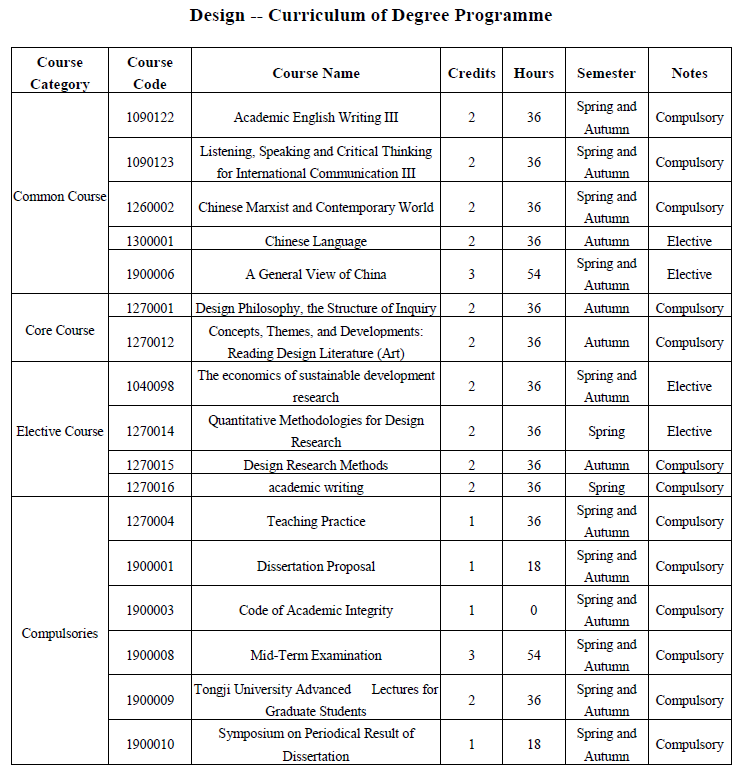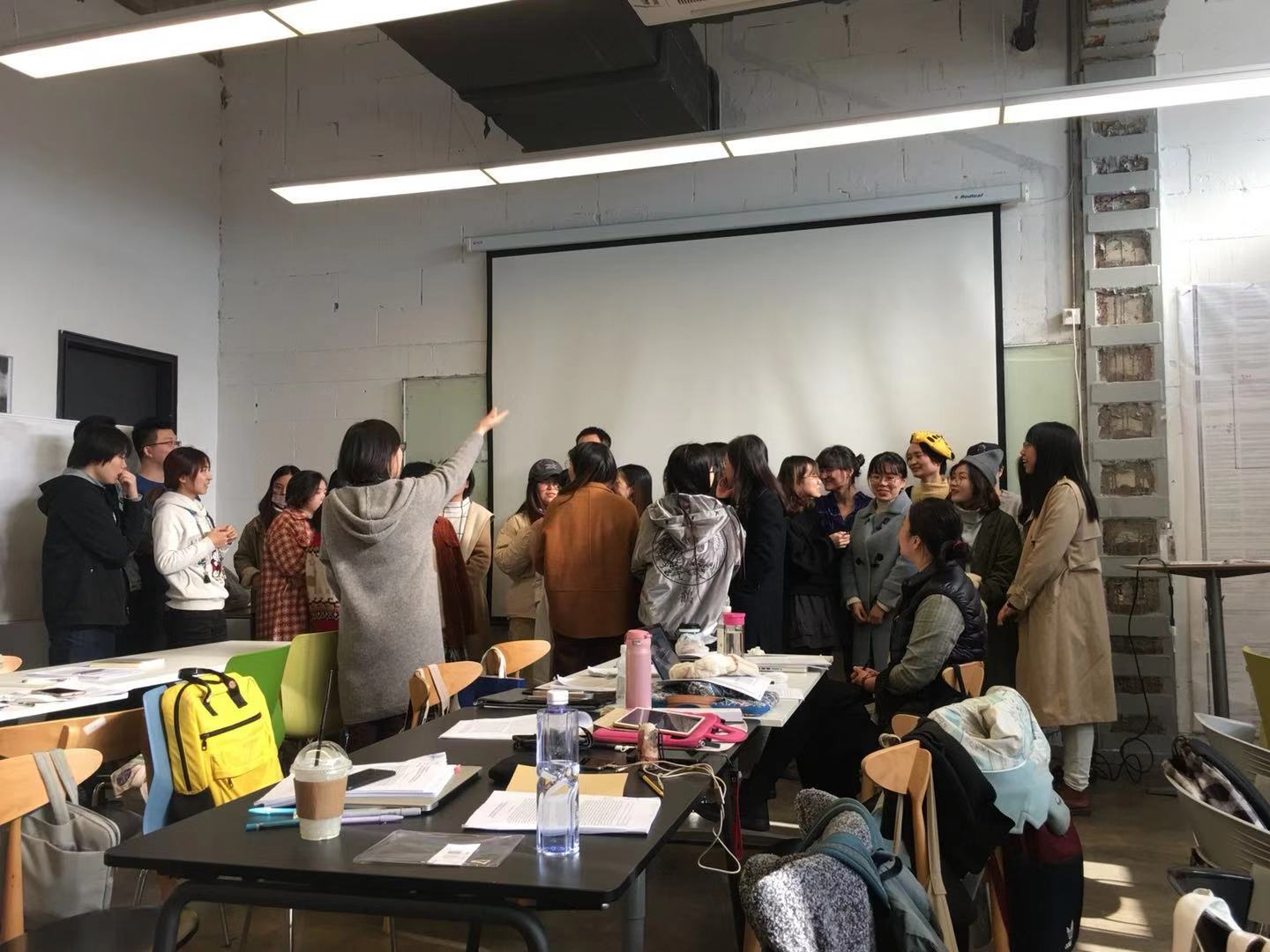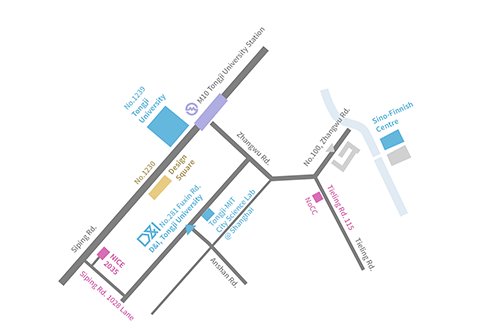I. Brief Introduction
Inspired by the 'Bauhaus', the design education of Tongji University was established in the 1940s, having a close relationship with the architecture education of the university. In 1986, the undergraduate program of Industrial Design initially accepted applications. In 2000, the undergraduate program of Art and Design was developed, in which Bachelor of Engineering and Bachelor of Arts can be conferred upon the students. In the same year, Tongji University obtained the degree-granting authority of Master of Design Art and students started to enroll in this program from 2001. In 2011, the university obtained the degree-granting authority of Master of Design and accepted the first intake of Master of Design students in 2012. In 1997, the government allowed the award of Master of Engineering (professional degree) and Tongji University began to accept the full-time students in Industrial Design Engineering domain in 2009. In addition, in 2009, the government allowed Tongji University to grant the Master of Fine Art (MFA), and shortly in 2010 Tongji's MFA program started to accept full-time students. Since 2002, the doctoral students studying design history and theory in Tongji University were granted Doctor of Engineering degree. In 2015, Tongji University obtained the degree-granting authority of Doctor of Design and accepted the first intake of Doctor of Design in 2016. The prospective doctoral graduates can be awarded either Doctor of Art degree or Doctor of Engineering degree.
This subject focusing on 'intelligent sustainable design for industrial transformation and future living', aims to cultivate the global leaders of 'sustainable design and innovation' in the knowledge economy network era, and integrates high standard design research to drive innovation, to lead the industry development and industrial upgrading, and finally to benefit all human beings.
This doctoral program emphasizes the education of academic talents in terms of Design Research and Design Innovation, highlighting abstract learning and thinking ability. The program encourages the students to conduct interdisciplinary academic researches on sustainable design, to achieve collaborative innovation with other subjects, to face the challenges from the real world, and to make contributions to the scientific development and social progress. This program has established double-degree doctoral programs with Swinburne University of Technology, Australia and the Hong Kong Polytechnic University, China. She Ji: The Journal of Design, Economics, and Innovation was founded in collaboration with Elsevier, a leading academic publishing house in the world.
II. Research Orientations
1. Design History & Theory
This subprogram aims to cultivate leading talents of design studies in the history, criticism, and theory of design, and in design education. It fosters the students’ academic design research capabilities situated in a pluralism of approaches that represent the ecology of design culture and the interdisciplinary context. Studies on the history of design aim to reveal the causes and patterns of the developments in design in the past, to reflect on and inform today’s practices and grasp the emerging trends. Studies on the theory of design aim to establish theories, principles, and methodologies to support designing for complex socio-technical systems that are full of ambiguities and uncertainties. Studies on design education inquire into the crucial issues in the cultivation of design-driven innovation talents.
2. Environment & Human Settlements
This subprogram focuses on the phenomenon of human settlements, and studies various design challenges and solutions for sustainable interaction between humans and nature, artificial systems and cyber systems, including human settlements, space and place, environmental psychology, emotion and experience, and smart living, urban-rural interaction, community building and social innovation. This subprogram will study the various foundations and forward-looking design theories, design methods, and design tools for creating and enabling a sustainable human settlement environment from a systematic, human-centered, and interdisciplinary perspective. This subprogram committed to cultivating leading design related academic talents who have speculation, originality, empathy, synergy, responsibility and global perspective.
3. Business & Innovation
This subprogram is based on the current status of global economic and social revolutions and national innovation-driven development strategies. It integrates multidisciplinary knowledge such as design, management, economics, and psychology, combines global innovation development trends and classical cases, and delves into design-driven industrial innovation, corporate and brand strategy, business management, product service systems, creativity stimulation, innovation and entrepreneurship, open innovation, sustainability innovation, and other theories, methods, and tools to cultivate advanced composite academic innovation leaders with strategic design thinking. This subprogram collaborates with governments, advanced think tanks and multinational corporations to carry out research on innovation methods such as evaluation and consulting on design competitiveness, evaluations on the value of design, and constructions of innovation ecosystems.
4. Media & Interaction
This subprogram focuses on the research of expression methods, interaction mechanisms, and supporting technologies of different media forms and interaction modalities. Students in this subprogram will study the digital means, intelligent techniques, and cross-disciplinary innovation theories, methods, and tools. Application of technology in design will be widely explored, in-depth analysis of emerging new media forms and interaction modalities will be conducted in this subprogram. The research topics in this subprogram include media computing, human-intelligent system interaction and services, usability and user experience, and innovative applications of new media forms such as AR/VR/MR, etc. This subprogram is dedicated to cultivating academic research leaders in the field of media and interaction design in the era of global knowledge networks.
5. Media & Interaction(Network and New Multi-Media)
This subprogram focuses on cultivating students' comprehensive ability in the direction of digital media art. The development of new media's audience contact characteristics and art generation technology has opened a media art revolution sweeping the world, new economic forms, business models, social ways, ways of public opinion expression, and artistic forms of expression have emerged. The research and practice of new media art and interaction involves new media theory, cultural communication, film and television art performance, brand communication, interactive design, animation games, etc. Combined with the latest international development trend, the research is carried out with the thinking of subject integration, and the art forms, creation rules and social effects under the condition of new technology are explored in depth.
Students can choose one of the above research directions for their doctoral study.
III. Program Duration
The duration of schooling for the Ph.D. students is 4 years with a maximum of no more than 7 years.
IV. Credit
Ph.D. students should complete at least 23 credits, including 4 credits for public degree courses, 4 credits for the professional degree courses, 6 credits for the non-degree courses (including at least 1 inter-college or interdisciplinary course with 2 credits), and 9 credits for the compulsory courses (including 1 credit for dissertation topic selection, 1 credit for the graduate students' academic behavior norms, 2 credits for the Tongji advanced lectures, 3 credits for the mid-term assessment, 1 credit for academic reporting conference on the phase achievement of the dissertation and 1 credit for teaching practice).
V. Dissertation
Graduate students should complete their dissertations independently under the supervision of their tutors. In principle, the dissertation should be written in Chinese, but overseas students may write in English, but they must attach to their dissertations detailed Chinese abstracts.
Doctoral students, whose dissertations are in Chinese, should submit at least an academic paper written in English (unpublished one is also acceptable), which is based on the dissertation.
1. Dissertation Topic Selection: The discussion of the Ph.D. dissertation topic selection should be organized by each discipline according to the time required by the university. In the course of the research, if there are significant changes in the thesis topic , the topic selection meeting shall be reorganized. If students fail to pass the first report, another topic selection meeting will be held 6 months later.
2. Mid-term comprehensive assessment: The mid-term comprehensive assessment of doctoral students should be organized by each discipline. Examination results will be recorded in the management information system according to each college in the form of grades. The proportion for excellence, fairly good is less than 40%, respectively; while the proportion for pass or fail is no less than 20%. Those who fail to pass the mid-term comprehensive assessment for the first time may apply for re-assessment six months later.
3. Pre-defense: Whether to organize pre-defense is determined by each discipline. The blind trial of the dissertation can only be carried out after the pre-defense is passed.
4. Blind trial: it should be conducted in accordance with the relevant provisions of the university and its colleges.
5. Oral defense: For the review, organization, approval and process of the doctoral dissertation, as well as the provision of advanced and deferred oral defense, please refer to the Regulations on the Training of Full-time Professional Master Graduate Students of Tongji University.
6. Confidential theses: Confidential management of secret-related thesis and applications for the academic degrees shall be carried out in accordance with the Regulations on the Management of Confidential Graduate Students and Confidential Thesis of Tongji University (No. 65, Tongji Graduate School, 2018).
VI. Research Papers
Before applying for graduation, the doctoral student should have published 3 academic papers (either published by International or Chinese journals or included in published proceedings of International Conferences) as the first author. It is also acceptable if the student publishes the paper as the second author with her/his supervisor as the first author. Among the student's publications, there should be at least 2 papers that is published by an SCI, SSCI, CSCD, A&HCI, or EI journal(Only one article published by CSCD journal can be deemed valid), and 1 paper that is included in officially published proceedings of journal or international academic conference that is authorized by D&I Academic Committee. During the study period, if the student receives one certificate of invention patent as the first named inventor, or as the second named inventor with her/his supervisor as the first named inventor, this achievement is regarded as equal to that of one journal or conference paper that is authorized by D&I Academic Committee.
Doctoral students, who have not reached the publication requirements but have accomplished this program, may also apply for the dissertation defense after obtaining the permission from the academic degree evaluation subcommittee. If the candidate would defend the dissertation successfully, she/he could apply for graduation. The degree application process should follow the instruction of the article VI in ‘Publication requirements to Master/Doctoral degree applicants of Tongji University’.




